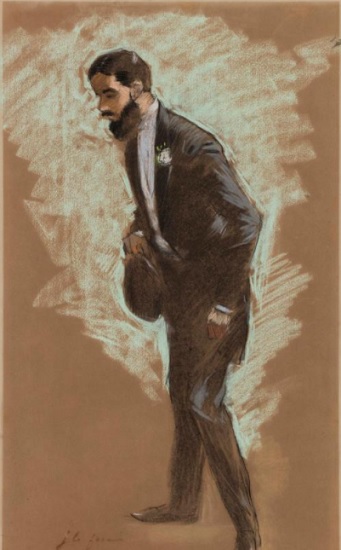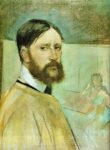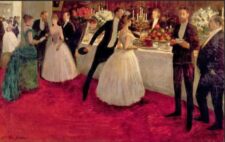
Jean Louis Forain
French, 1852-1931
Portrait of Giuseppe De Nittis, 1884
pastel on paper
25 7/8 x 17 5/8 in.
SBMA, Bequest of Margaret Mallory
1998.50.31

Jean Louis Forain, Self-Portrait, n.d.
"Forain, my noble friend, how beautiful your drawing is! And no caption. Cassation suffices. The head is magnificent. How much one can say with a drawing!" - Letter from Degas to Forain, 9 April 1898

Jean Louis Forain - The Buffet, 1884
COMMENTS
Although Forain was interested in the Impressionist painters’ ideas and techniques from the late 1870s on, the year 1879 marks the beginning of Forain’s Impressionist style, which continued to 1900. During this time, many of his paintings were influenced by an interest in light, a free, painterly brushstroke, and the subject matter of the Impressionist group, including a number of scenes “en plein air”. An oil of l884-85, “Champ de course” exemplifies this change in style, in which Forain uses an Impressionist palette and techniques to produce a luminous, light-suffused landscape with brilliant hues of green and gold. Although Forain concentrates on the fugitive effects of light in the landscape in this work, he does not relinquish his interest in figures and especially people in characteristic poses and activities. His keen interest in people is also evident in his scenes of Parisian life of this period, such as “Au Skating”.
From I882 to I885, due to the lack of Impressionist exhibitions, Forain had no place to show his work. He again resolved to storm the citadel of high art by submitting a large, ambitious oil painting, “Le Bufiet”, to the Salon des Artistes Francais in I884. It was accepted and proclaimed Forain’s interest in being known as a painter as well as a printmaker and illustrator. “Le Buflet” shows a group of men and women in evening dress standing near a buffet table in the upper right background. Forain’s skill in composition is reflected in the complex interlocking organization of the figures. Although the colors are more subdued than in Forain’s more Impressionist works, and black is used, the diagonal line of the buffet table on the right leading the viewer into the picture, the low viewing angle and tilted perspective proclaim the influence of the Japanese print, a great interest of Impressionist painters.
In 1885 Forain again successfully entered the Salon des Artistes Francais with "The Widower", now in the Louvre. The painting is skillfully composed, a diagonal on the right leading the eye into the picture, contrasted with the opposing diagonal of the shelves on the left. A light area of salmon and blue stripes on the chair surrounds and emphasizes the isolated seated figure of the brooding widower, the painterly surface proclaiming its Impressionist technique.
Another tie with the lmpressionist painters was Forain’s association with the dealer Ambroise Vollard, whom he met in 1886. Vollard had come from the French colony, La Reunion, and was studying law. He admired Forain’s drawings for Le Courrier Francais in 1887 and purchased one for a client. Thereafter, Vollard became the artists dealer and patron, commissioning a number of lithographs from 1897 to around 1910. One of these, an outstanding portrait of Vollard himself of around 1910, emphasizes the dealer’s bulk through a triangular composition. Vollard is presented as a stable, monumental and somewhat daunting figure. It is a forceful portrait of a forceful man.
Forain’s first one-man exhibition was at the Galerie Boussod-Valadon on the boulevard Montmartre in 1890, in which he showed a number of his drawings. In this year Forain also began to make lithographs, for which he temporarily abandoned etching.
Forain approached lithography as an experienced draftsman. He was able by the late 1890s to create lithographs which had the freedom of drawings, as in “Portrait of Mme. de Bonniéres” or “La tasse de lait”, a portrait of Forain’s wife and son. It was as a lithographer that Forain attracted the attention of Marcel Guérin, a print collector, dealer and cataloguer. Guérin first catalogued Forain’s lithographs in 1910, and in 1912 published a catalogue of Forain’s etchings, drypoints and monotypes.
- Alicia Faxon, Jean-Louis Forain: Artist, Realist, Humanist, Baltimore: International Exhibition Foundation, 1982, 20-24
SBMA CURATORIAL LABELS
A follower of Degas, whom he emulated in his devotion to the observation of urban experience and its endlessly fascinating participants, Forain was an active member of the Impressionist group. He is perhaps better remembered today as a biting caricaturist who followed in the footsteps of Daumier in his prints for magazines like Le Figaro. In this rapidly executed pastel, Forain captures the nimble step and fashionable attire of fellow artist, Giuseppe de Nittis. The Italian De Nittis exhibited in the First Impressionist exhibition in 1874. Tragically, he died prematurely of a stroke at the age of thirty-eight, at the height of his artistic powers and celebrity in 1884, the very year this pastel was done. One wonders if the talented Forain was able to swiftly conjure his good friend from recent memory or if this is one of the last direct portraits of De Nittis that we have.
Though Van Gogh possessed none of Forain’s virtuosic facility as a draftsman, he recognized the accuracy of his depictions of social types, which he commented on approvingly to his brother Theo.
- Through Vincent's Eyes, 2022
